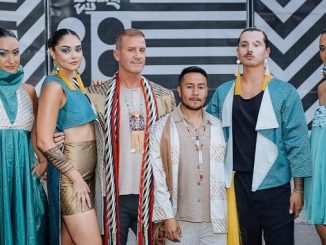Throughout the pandemic, luxury fashion as an industry has transformed, both with regards to brands’ goals as well as consumers’ mindsets. Ever-changing restrictions kept storefronts closed, disrupted supply chains in factories, and even altered consumer buying patterns. Along with these changes came an uprising of social justice movements throughout the pandemic, many of which brought to light important social, political, and environmental issues. As these topics spread like wildfire throughout the population, so did information regarding the injustices and the harms of the fashion industry. Combined with consumers’ ability to absorb such information given newfound free time in isolation, brands were forced to adapt quickly to this new normal and to the changes in consumer preferences.

Sustainability had been somewhat of a “hot topic” for several years prior, with small strides in the industry having been made in response to consumer demand. However, with increased access to information throughout the pandemic, consumer awareness skyrocketed, creating a strong market for sustainably and ethically made fashion, prioritizing the environment. While this demand spawned changes within brands that had already been inching towards the sustainable fashion space, it also affected brands not previously looking to improve sustainability. “We saw many brands continue with their sustainability commitments, and some brands even ramped up those efforts and accelerated those initiatives. Brands that were not as involved in sustainability pre-pandemic probably realized that sustainability is something that will drive success in the future”, said Elina Nurkka, Director of Innovation, Research and Sustainability at Nobis. Thus, while pandemic-related restrictions did inflict change upon brands, the real change came when the pandemic gave rise to a new wave of consumer apprehension.
Previous to the recent outpouring of demand for sustainable fashion, there had been a steady evolution of sustainable shifts in fashion over the past 20 years. It all began in the early 1990s when social injustice had just been exposed in the fashion industry, with sweatshops in Asia and child labor being uncovered. These were some of the first discoveries to make their way to the media, condemning the social impact of fast fashion, and encouraging many brands to clean up their image by working with factories that were audited to ensure that their supply chains were socially responsible. Then came a wave of toxic chemical exposures, where some factories were found to leak large amounts of the toxic chemicals from their dyeing and finishing processes into rivers and lakes, many of which were very hazardous to the environment and wildlife. “That’s when we began cleaning up the chemicals from the supply chain. Work to phase them out continues today, as new chemicals are still being identified on a regular basis that are classified as hazardous”, Elina said.
The most recent developments in the sustainability sector of fashion have been combating overproduction, evaluating how to prevent the accumulation of textile waste in landfills, extend the reusability of products, and decrease Greenhouse Gas (GHG) emissions during the production process. The negative environmental implications of the conventional materials in fashion have called for sustainable solutions in the luxury industry, both on the synthetic and natural sides of the textile industry.
Traditionally, virgin synthetic materials had been used in clothing production, such as polyester and nylon, which by nature are fossil fuels based, contributing to GHG emissions. They also contain plastic synthetic fibres, which are not biodegradable in nature and thus can take up to hundreds of years to decompose once they end up in the landfill, which they inevitably will due to their lower durability. Even natural materials, such as cotton, wool, or silk, despite their misleading names which suggest a lower environmental impact, actually require a large amount of water and pesticides to produce, taking a large toll on the environment and surrounding wildlife as well.

A main focus surrounding synthetic materials has been creating functional materials, including materials laminated with waterproof breathable membranes and water repellent treatments. As Elina explained, “it’s very important that the materials perform to the criteria because adding these treatments and properties to a materials make them less sustainable to produce than a fabric without these treatments.” Seeing as these criteria require significantly improved durability and performance, clothing with these treatments have improved longevity, thus creating less waste and therefore contributing to less gross clothing production. To combat the water waste and excessive pesticide usage within the natural materials processes, sustainable regulations such as organic cotton standards have been put in place, requiring growers to reduce pesticide and water consumption.
Other solutions within the luxury fashion industry to help reduce waste as well as increase recyclability of clothing items have been digital simulations and garment rental services. By using a digital format to continue product development while eliminating waste from physical samples and GHG emissions from shipping, the technologies have allowed brands to digitally create patterns to then be manipulated into a garment that can be fit onto a 3D avatar. In addition, by launching garment rental and resale services, brands can extend the lifespan of their clothing by increasing the number of wears a garment receives, as well as by reselling the garment after its first owner.
All of these solutions feed into the greater idea of fashion circularity, one that will revolutionize the luxury fashion world as the sustainability movement rages on. As we can see from the recent strides towards quality and waste reduction, the fashion industry has been going in the direction of complete recyclability. While many solutions that would facilitate recycling and therefore circularity are technologies, they’re not readily available to use across the industry today. However, it is important that brands begin to assess the potential of their materials and products, such as their textiles’ recyclability and end life implications, so that when these solutions do become available at scale, more products will be suitable for these recycling processes or at least to be repurposed into new products.
Elina explained, “ideally no textile should end up in the landfill. At Nobis, we have products that are very complex, with several different components made of different raw materials, so for us, it’s actually really challenging to design for recyclability. That’s why at first we aim to maximize the life cycle of our products, such as high quality, durable materials, timeless and classic designs, that won’t go out of trend quickly, keeping these products in use for as long as possible. That’s our Number 1 priority.”




